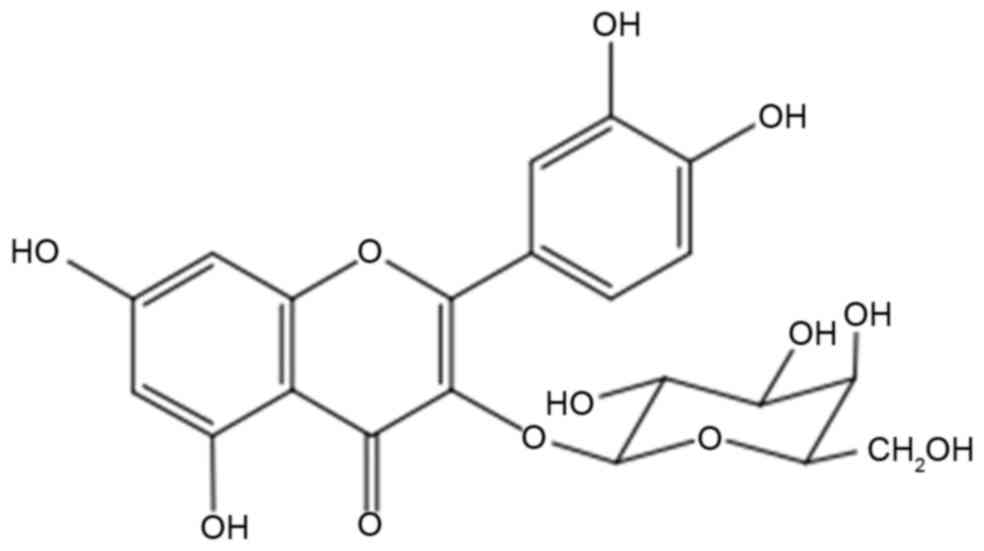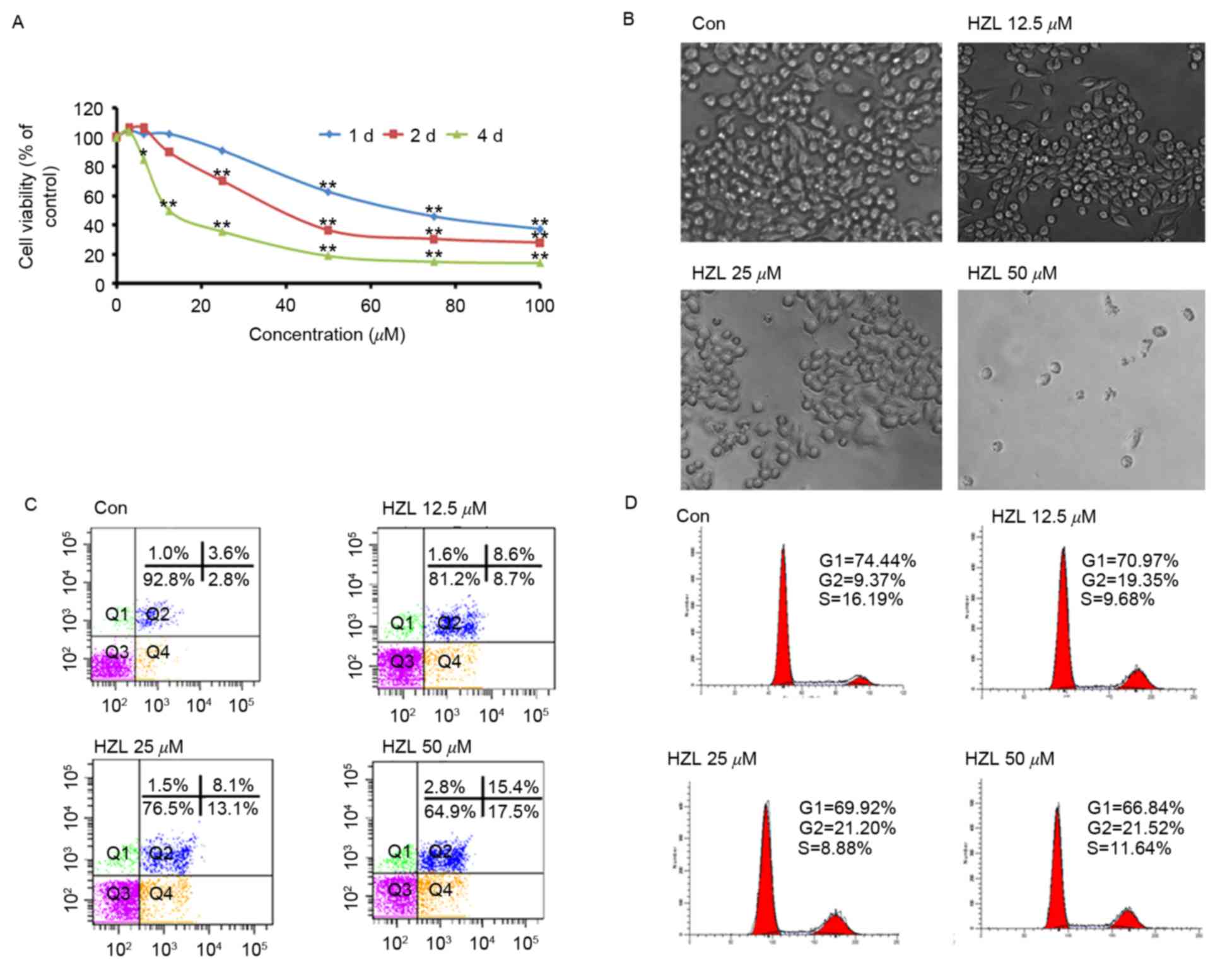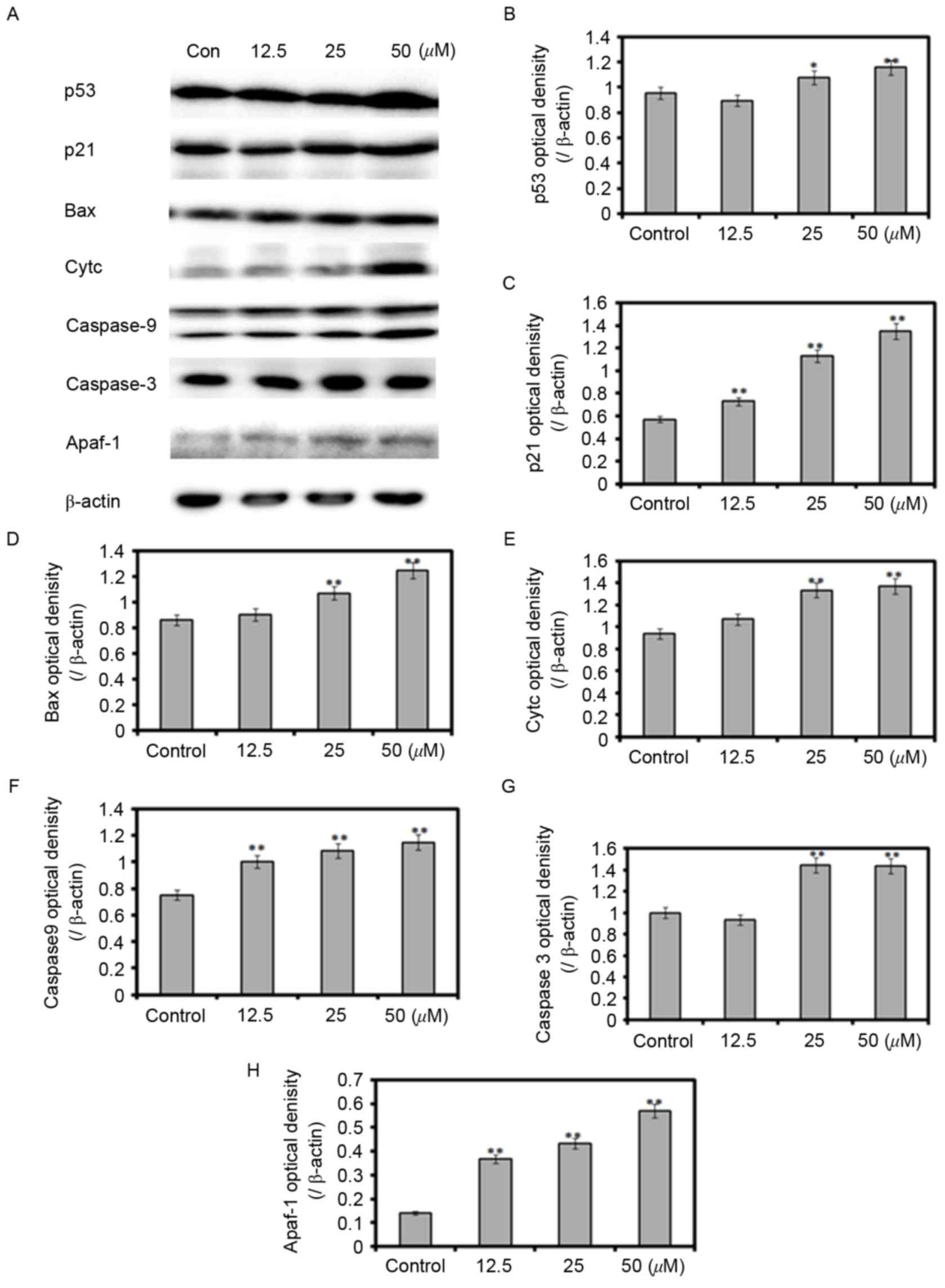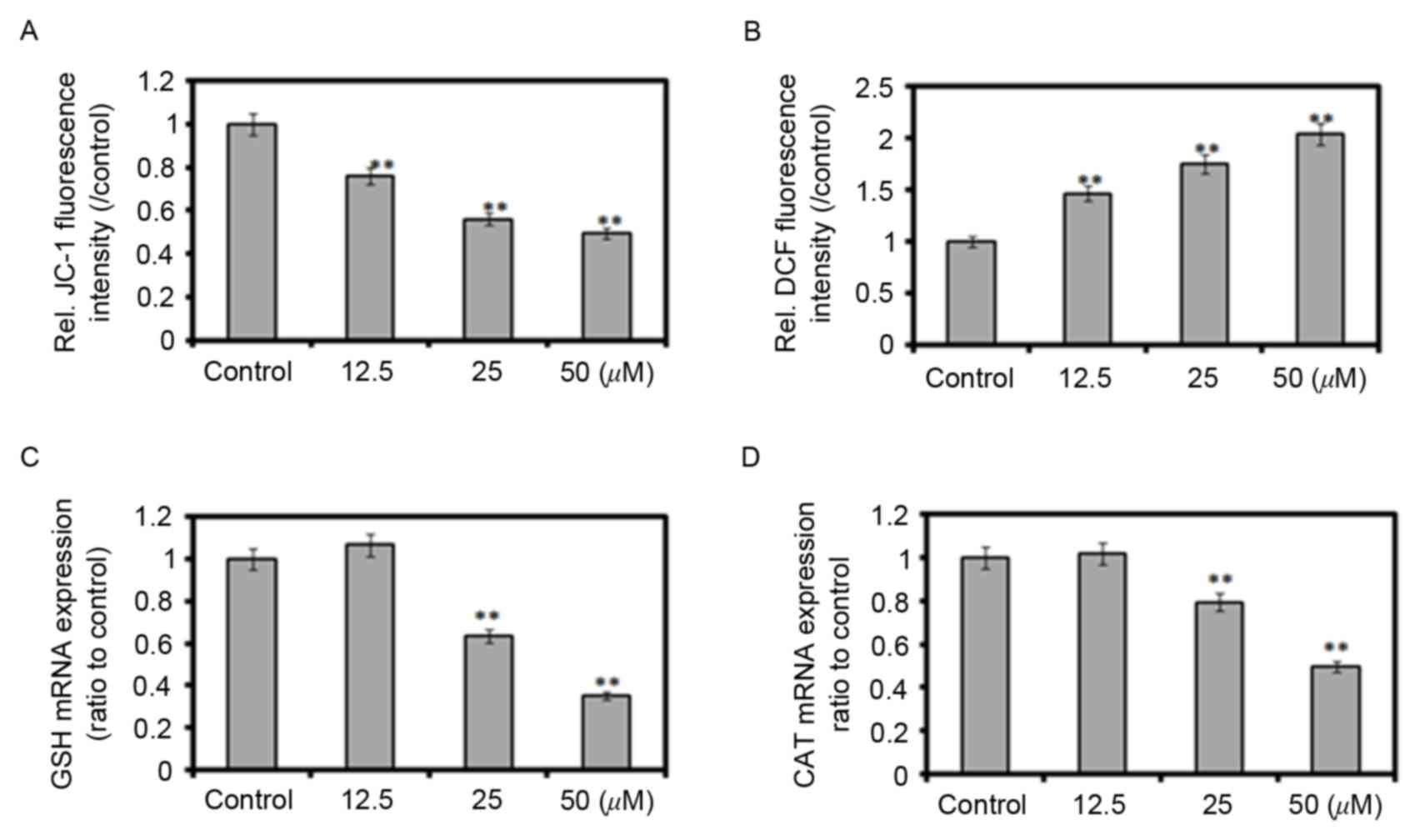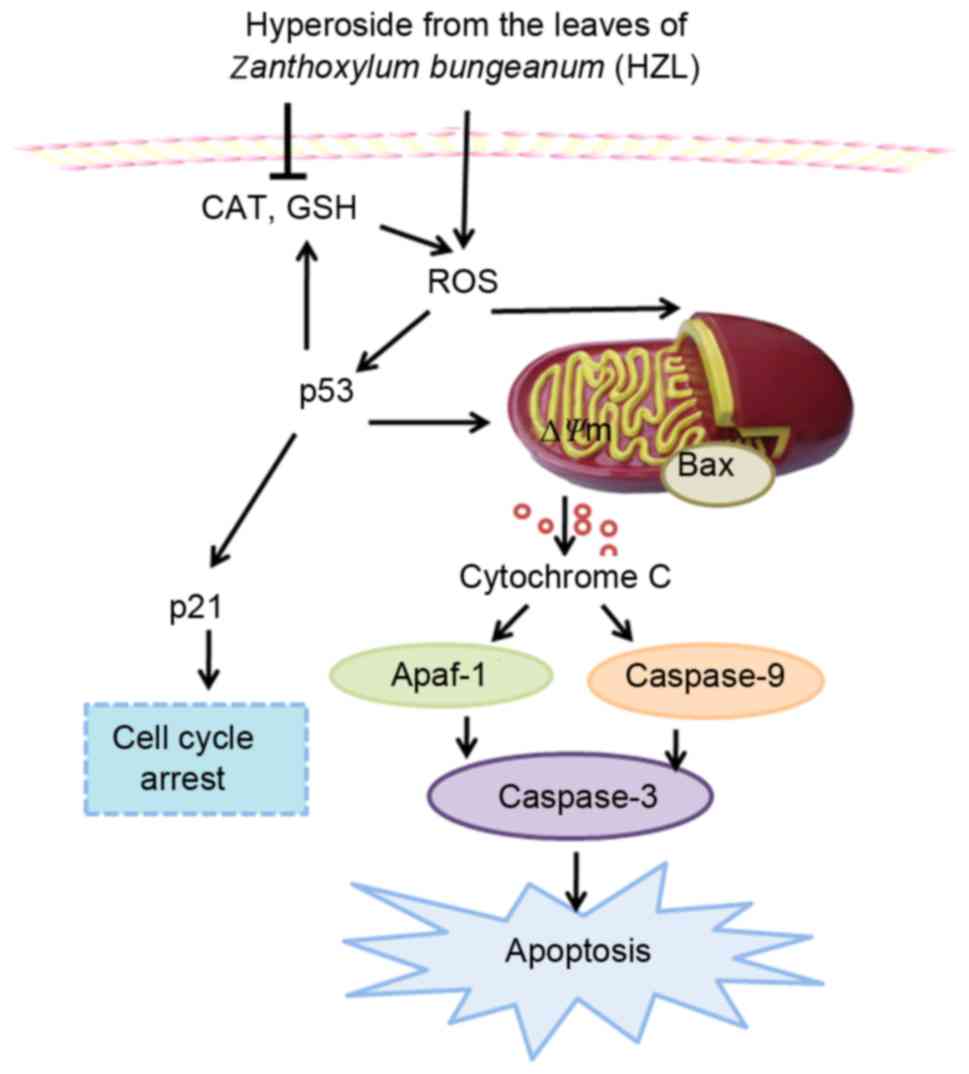|
1
|
Amado NG, Predes D, Moreno MM, Carvalho
IO, Mendes FA and Abreu JG: Flavonoids and Wnt/β-catenin signaling:
Potential role in colorectal cancer therapies. Int J Mol Sci.
15:12094–12106. 2014. View Article : Google Scholar : PubMed/NCBI
|
|
2
|
Luo X, Yu X, Liu S, Deng Q, Liu X, Peng S,
Li H, Liu J and Cao Y: The role of targeting kinase activity by
natural products in cancer chemoprevention and chemotherapy
(Review). Oncol Rep. 34:547–554. 2015.PubMed/NCBI
|
|
3
|
Miura K, Satoh M, Kinouchi M, Yamamoto K,
Hasegawa Y, Kakugawa Y, Kawai M, Uchimi K, Aizawa H, Ohnuma S, et
al: The use of natural products in colorectal cancer drug
discovery. Expert Opin Drug Discov. 10:411–426. 2015. View Article : Google Scholar : PubMed/NCBI
|
|
4
|
Xiong QB and Shi DW: Morphological and
histological studies of Chinese traditional drug ‘hua jiao’
(Pericarpium Zanthoxyli) and its allied drugs. Yao Xue Xue Bao.
26:938–947. 1991.(In Chinese). PubMed/NCBI
|
|
5
|
Zhang Y, Luo Z and Wang D: Efficient
quantification of the phenolic profiles of Zanthoxylum bungeanum
leaves and correlation between chromatographic fingerprint and
antioxidant activity. Nat Prod Res. 29:2024–2029. 2015. View Article : Google Scholar : PubMed/NCBI
|
|
6
|
Zhang Y, Wang D, Yang L, Zhou D and Zhang
J: Purification and characterization of flavonoids from the leaves
of Zanthoxylum bungeanum and correlation between their structure
and antioxidant activity. PLoS One. 9:e1057252014. View Article : Google Scholar : PubMed/NCBI
|
|
7
|
Yang LC, Li R, Tan J and Jiang ZT:
Polyphenolics composition of the leaves of Zanthoxylum bungeanum
Maxim. Grown in Hebei, China, and their radical scavenging
activities. J Agric Food Chem. 61:1772–1778. 2013. View Article : Google Scholar : PubMed/NCBI
|
|
8
|
Zhang Y, Luo Z, Wang D, He F and Li D:
Phytochemical profiles and antioxidant and antimicrobial activities
of the leaves of Zanthoxylum bungeanum. ScientificWorldJournal.
2014:1810722014.PubMed/NCBI
|
|
9
|
Yang Q, Cao W, Zhou X, Cao W, Xie Y and
Wang S: Anti-thrombotic effects of α-linolenic acid isolated from
Zanthoxylum bungeanum Maxim seeds. BMC Complement Altern Med.
14:3482014. View Article : Google Scholar : PubMed/NCBI
|
|
10
|
Wu T, Zhong L, Hong Z, Li Y, Liu X, Pan L,
Xin H and Zhu Y: The effects of Zanthoxylum bungeanum extract on
lipid metabolism induced by sterols. J Pharmacol Sci. 127:251–259.
2015. View Article : Google Scholar : PubMed/NCBI
|
|
11
|
Sukito A and Tachibana S: Isolation of
hyperoside and isoquercitrin from Camellia sasanqua as antioxidant
agents. Pak J Biol Sci. 17:999–1006. 2014. View Article : Google Scholar : PubMed/NCBI
|
|
12
|
Yang FQ, Liu M, Li W, Che JP, Wang GC and
Zheng JH: Combination of quercetin and hyperoside inhibits prostate
cancer cell growth and metastasis via regulation of microRNA21. Mol
Med Rep. 11:1085–1092. 2015.PubMed/NCBI
|
|
13
|
Huo Y, Yi B, Chen M, Wang N, Chen P, Guo C
and Sun J: Induction of Nur77 by hyperoside inhibits vascular
smooth muscle cell proliferation and neointimal formation. Biochem
Pharmacol. 92:590–598. 2014. View Article : Google Scholar : PubMed/NCBI
|
|
14
|
Li FR, Yu FX, Yao ST, Si YH, Zhang W and
Gao LL: Hyperin extracted from Manchurian rhododendron leaf induces
apoptosis in human endometrial cancer cells through a mitochondrial
pathway. Asian Pac J Cancer Prev. 13:3653–3656. 2012. View Article : Google Scholar : PubMed/NCBI
|
|
15
|
Lee JH, Ahn J, Kim JW, Lee SG and Kim HP:
Flavonoids from the aerial parts of Houttuynia cordata attenuate
lung inflammation in mice. Arch Pharm Res. 38:1304–1311. 2015.
View Article : Google Scholar : PubMed/NCBI
|
|
16
|
Fu T, Wang L, Jin XN, Sui HJ, Liu Z and
Jin Y: Hyperoside induces both autophagy and apoptosis in non-small
cell lung cancer cells in vitro. Acta Pharmacol Sin. 37:505–518.
2016. View Article : Google Scholar : PubMed/NCBI
|
|
17
|
Li W, Liu M, Xu YF, Feng Y, Che JP, Wang
GC and Zheng JH: Combination of quercetin and hyperoside has
anticancer effects on renal cancer cells through inhibition of
oncogenic microRNA-27a. Oncol Rep. 31:117–124. 2014.PubMed/NCBI
|
|
18
|
Khan HY, Zubair H, Ullah MF, Ahmad A and
Hadi SM: A prooxidant mechanism for the anticancer and
chemopreventive properties of plant polyphenols. Curr Drug Targets.
13:1738–1749. 2012. View Article : Google Scholar : PubMed/NCBI
|
|
19
|
Bayir H, Fadeel B, Palladino MJ, Witasp E,
Kurnikov IV, Tyurina YY, Tyurin VA, Amoscato AA, Jiang J, Kochanek
PM, et al: Apoptotic interactions of cytochrome c: Redox flirting
with anionic phospholipids within and outside of mitochondria.
Biochim Biophys Acta. 1757:648–659. 2006. View Article : Google Scholar : PubMed/NCBI
|
|
20
|
Li PF, Dietz R and von Harsdorf R: p53
regulates mitochondrial membrane potential through reactive oxygen
species and induces cytochrome c-independent apoptosis blocked by
Bcl-2. EMBO J. 18:6027–6036. 1999. View Article : Google Scholar : PubMed/NCBI
|
|
21
|
The Ninth Chinese Pharmacopoeia,
Commission of the People's Republic of China, . Pharmacopoeia of
the People's Republic of China. The Medicine Science and Technology
Press of China; 2010
|
|
22
|
Livak KJ and Schmittgen TD: Analysis of
relative gene expression data using real-time quantitative PCR and
the 2(−Delta Delta C(T)) method. Methods. 25:402–408. 2001.
View Article : Google Scholar : PubMed/NCBI
|
|
23
|
Procházková D, Bousová I and Wilhelmová N:
Antioxidant and prooxidant properties of flavonoids. Fitoterapia.
82:513–523. 2011. View Article : Google Scholar : PubMed/NCBI
|
|
24
|
Catanzaro D, Ragazzi E, Vianello C,
Caparrotta L and Montopoli M: Effect of quercetin on cell cycle and
cyclin expression in ovarian carcinoma and osteosarcoma cell lines.
Nat Prod Commun. 10:1365–1368. 2015.PubMed/NCBI
|
|
25
|
Celano M, Maggisano V, de Rose RF, Bulotta
S, Maiuolo J, Navarra M and Russo D: Flavonoid fraction of citrus
reticulata juice reduces proliferation and migration of anaplastic
thyroid carcinoma cells. Nutr Cancer. 67:1183–1190. 2015.
View Article : Google Scholar : PubMed/NCBI
|
|
26
|
Song H, Bao J, Wei Y, Chen Y, Mao X, Li J,
Yang Z and Xue Y: Kaempferol inhibits gastric cancer tumor growth:
An in vitro and in vivo study. Oncol Rep. 33:868–874.
2015.PubMed/NCBI
|
|
27
|
Li C, Yang X, Chen C, Cai S and Hu J:
Isorhamnetin suppresses colon cancer cell growth through the
PI3K-Akt-mTOR pathway. Mol Med Rep. 9:935–940. 2014.PubMed/NCBI
|
|
28
|
Zhang N, Ying MD, Wu YP, Zhou ZH, Ye ZM,
Li H and Lin DS: Hyperoside, a flavonoid compound, inhibits
proliferation and stimulates osteogenic differentiation of human
osteosarcoma cells. PLoS One. 9:e989732014. View Article : Google Scholar : PubMed/NCBI
|
|
29
|
Lu M, Huang W, Bao N, Zhou G and Zhao J:
The flavonoid ampelopsin inhibited cell growth and induced
apoptosis and G0/G1 arrest in human osteosarcoma MG-63 cells in
vitro. Pharmazie. 70:388–393. 2015.PubMed/NCBI
|
|
30
|
Yi JL, Shi S, Shen YL, Wang L, Chen HY,
Zhu J and Ding Y: Myricetin and methyl eugenol combination enhances
the anticancer activity, cell cycle arrest and apoptosis induction
of cis-platin against HeLa cervical cancer cell lines. Int J Clin
Exp Pathol. 8:1116–1127. 2015.PubMed/NCBI
|
|
31
|
Wang P, Wang B, Chung S, Wu Y, Henning SM
and Vadgama JV: Increased chemopreventive effect by combining
arctigenin, green tea polyphenol and curcumin in prostate and
breast cancer cells. RSC Adv. 4:35242–35250. 2014. View Article : Google Scholar : PubMed/NCBI
|
|
32
|
Wu Z, Wu L, Li L, Tashiro S, Onodera S and
Ikejima T: p53-mediated cell cycle arrest and apoptosis induced by
shikonin via a caspase-9-dependent mechanism in human malignant
melanoma A375-S2 cells. J Pharmacol Sci. 94:166–176. 2004.
View Article : Google Scholar : PubMed/NCBI
|
|
33
|
Zhu F, Dollé ME, Berton TR, Kuiper RV,
Capps C, Espejo A, McArthur MJ, Bedford MT, van Steeg H, de Vries A
and Johnson DG: Mouse models for the p53 R72P polymorphism mimic
human phenotypes. Cancer Res. 70:5851–5859. 2010. View Article : Google Scholar : PubMed/NCBI
|
|
34
|
Waga S, Hannon GJ, Beach D and Stillman B:
The p21 inhibitor of cyclin-dependent kinases controls DNA
replication by interaction with PCNA. Nature. 369:574–578. 1994.
View Article : Google Scholar : PubMed/NCBI
|
|
35
|
Fiers W, Beyaert R, Declercq W and
Vandenabeele P: More than one way to die: Apoptosis, necrosis and
reactive oxygen damage. Oncogene. 18:7719–7730. 1999. View Article : Google Scholar : PubMed/NCBI
|
|
36
|
Pallardy M, Perrin-Wolff M and Biola A:
Cellular stress and apoptosis. Toxicol In Vitro. 11:573–578. 1997.
View Article : Google Scholar : PubMed/NCBI
|
|
37
|
Miyashita T, Krajewski S, Krajewska M,
Wang HG, Lin HK, Liebermann DA, Hoffman B and Reed JC: Tumor
suppressor p53 is a regulator of bcl-2 and bax gene expression in
vitro and in vivo. Oncogene. 9:1799–1805. 1994.PubMed/NCBI
|
|
38
|
Ni CH, Yu CS, Lu HF, Yang JS, Huang HY,
Chen PY, Wu SH, Ip SW, Chiang SY, Lin JG and Chung JG:
Chrysophanol-induced cell death (necrosis) in human lung cancer
A549 cells is mediated through increasing reactive oxygen species
and decreasing the level of mitochondrial membrane potential.
Environ Toxicol. 29:740–749. 2014. View Article : Google Scholar : PubMed/NCBI
|
|
39
|
Soengas MS, Alarcón RM, Yoshida H, Giaccia
AJ, Hakem R, Mak TW and Lowe SW: Apaf-1 and caspase-9 in
p53-dependent apoptosis and tumor inhibition. Science. 284:156–159.
1999. View Article : Google Scholar : PubMed/NCBI
|
|
40
|
Zeng KW, Wang XM, Ko H, Kwon HC, Cha JW
and Yang HO: Hyperoside protects primary rat cortical neurons from
neurotoxicity induced by amyloid β-protein via the
PI3K/Akt/Bad/Bcl(XL)-regulated mitochondrial apoptotic pathway. Eur
J Pharmacol. 672:45–55. 2011. View Article : Google Scholar : PubMed/NCBI
|
|
41
|
Liu S, Yan B, Lai W, Chen L, Xiao D, Xi S,
Jiang Y, Dong X, An J, Chen X, et al: As a novel p53 direct target,
bidirectional gene HspB2/αB-crystallin regulates the ROS level and
Warburg effect. Biochim Biophys Acta. 1839:592–603. 2014.
View Article : Google Scholar : PubMed/NCBI
|
|
42
|
Haklar G, Sayin-Ozveri E, Yüksel M, Aktan
AO and Yalcin AS: Different kinds of reactive oxygen and nitrogen
species were detected in colon and breast tumors. Cancer Lett.
165:219–224. 2001. View Article : Google Scholar : PubMed/NCBI
|
|
43
|
Rainis T, Maor I, Lanir A, Shnizer S and
Lavy A: Enhanced oxidative stress and leucocyte activation in
neoplastic tissues of the colon. Dig Dis Sci. 52:526–530. 2007.
View Article : Google Scholar : PubMed/NCBI
|
|
44
|
Bai J and Cederbaum AI: Catalase protects
HepG2 cells from apoptosis induced by DNA-damaging agents by
accelerating the degradation of p53. J Biol Chem. 278:4660–4667.
2003. View Article : Google Scholar : PubMed/NCBI
|
|
45
|
Kang MY, Kim HB, Piao C, Lee KH, Hyun JW,
Chang IY and You HJ: The critical role of catalase in prooxidant
and antioxidant function of p53. Cell Death Differ. 20:117–129.
2013. View Article : Google Scholar : PubMed/NCBI
|
|
46
|
Fan S, Yu Y, Qi M, Sun Z, Li L, Yao G,
Tashiro S, Onodera S and Ikejima T: P53-mediated GSH depletion
enhanced the cytotoxicity of NO in silibinin-treated human cervical
carcinoma HeLa cells. Free Radic Res. 46:1082–1092. 2012.
View Article : Google Scholar : PubMed/NCBI
|



